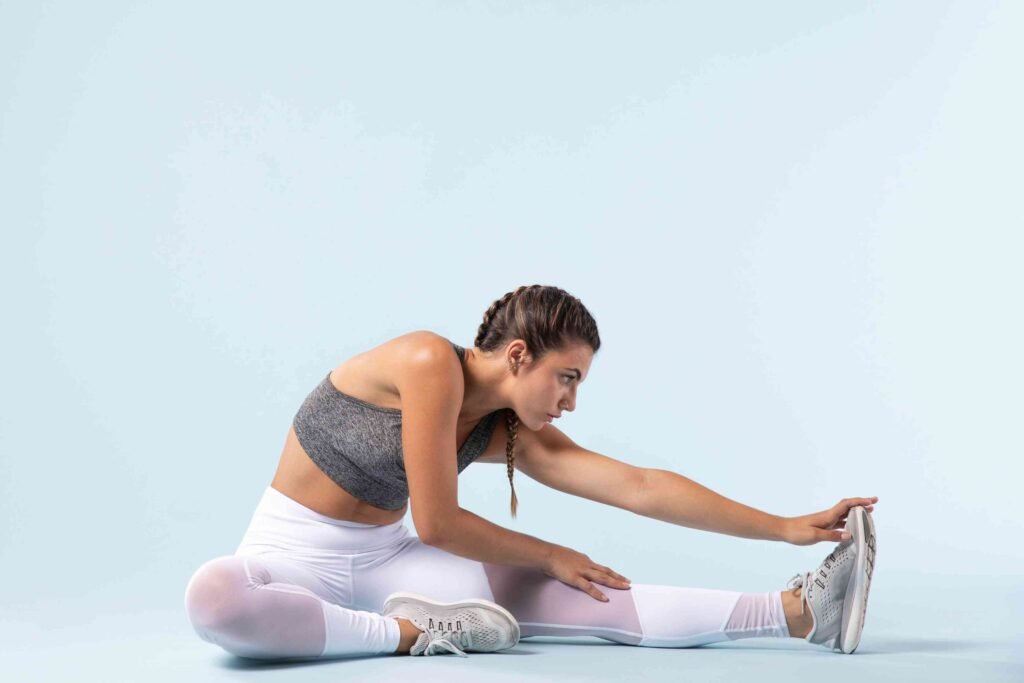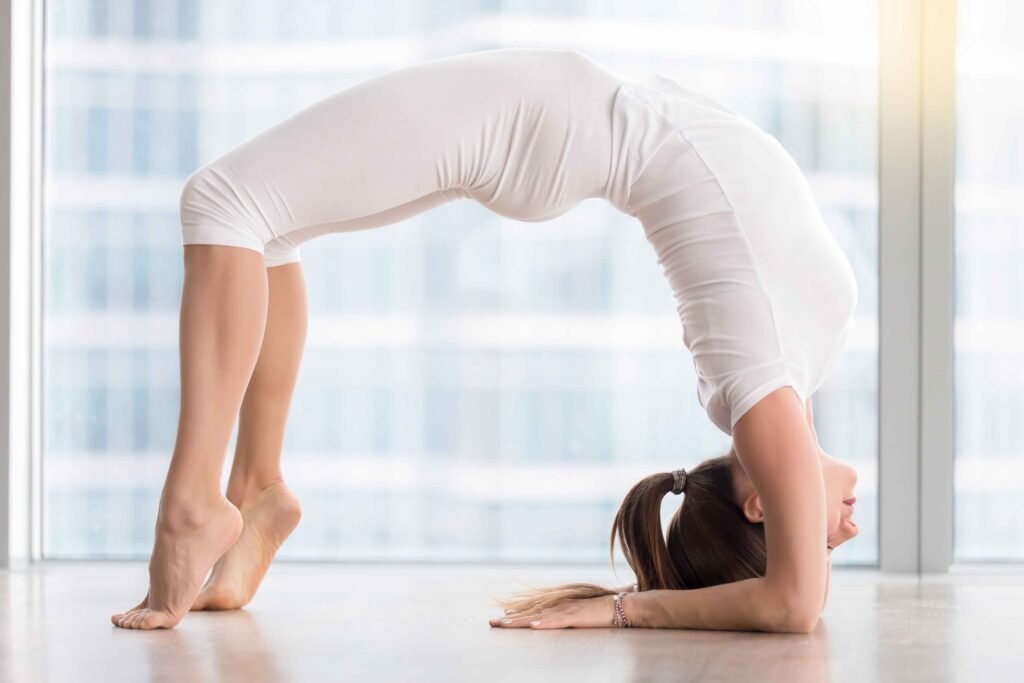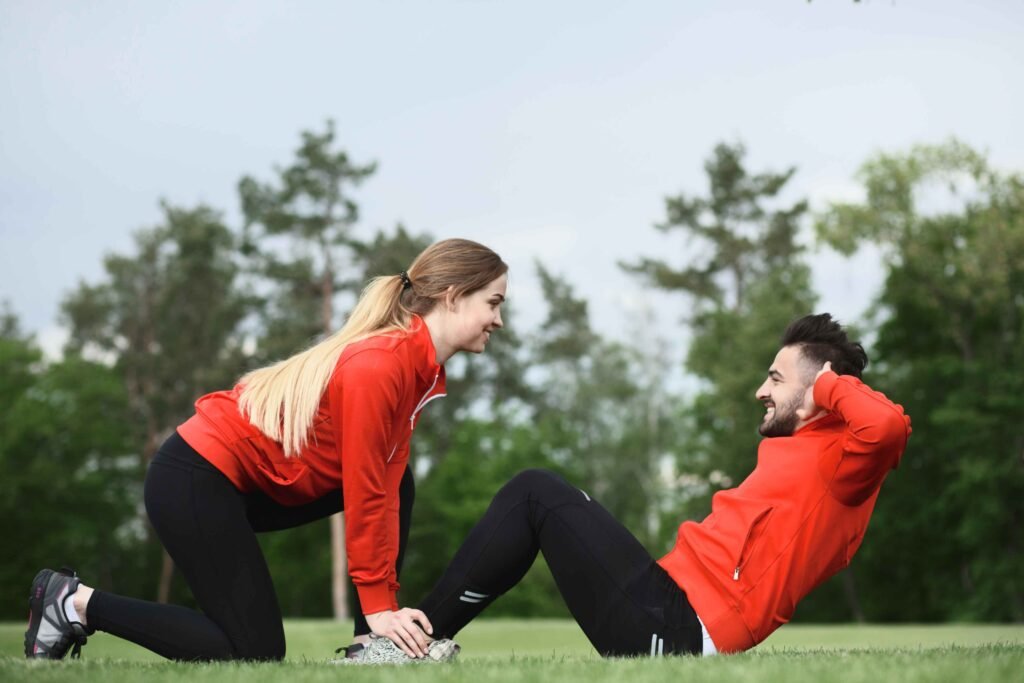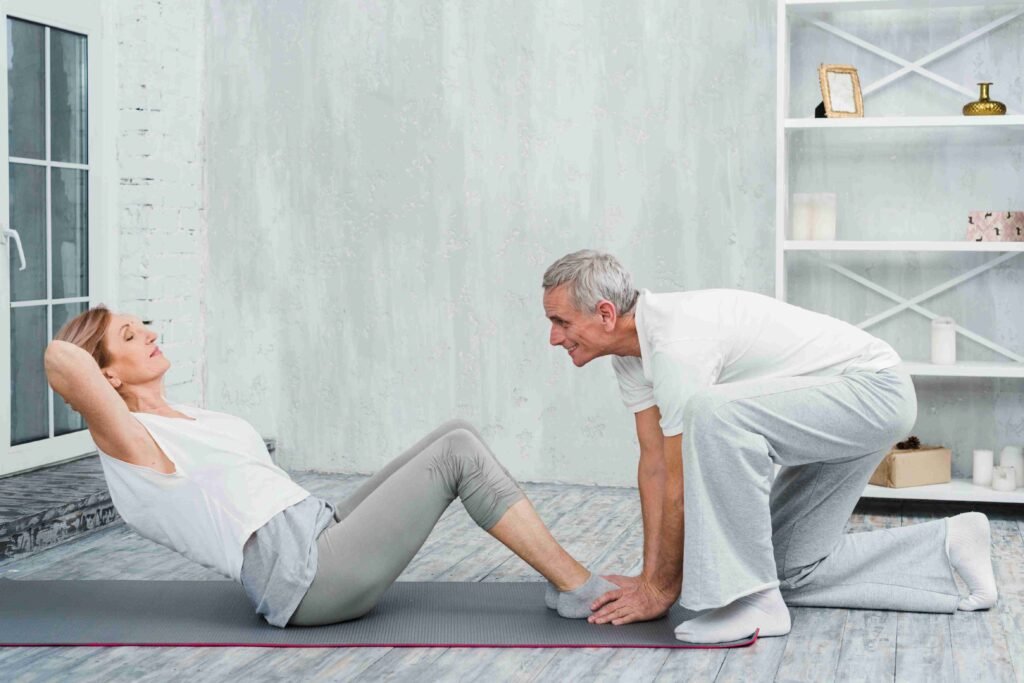| This article is medically reviewed by Dr Harcharanjit Singh Randhawa |
Introduction :
It is easy to neglect our physical well being in today’s fast-paced world. However, incorporating simple stretches into your daily routine can have numerous benefits for your body and mind.
Whether you’re an athlete, an office worker, or someone who simply wants to maintain their overall health, adding a few minutes of stretching to your day can work wonders.
In this article, we will explore a variety of simple stretches that target different muscle groups, promote flexibility, and help prevent injuries. So, let’s dive in and discover the power of simple stretches!
1. The Importance of Stretching

1.1 What Are Simple Stretches ?
Simple stretches refer to basic stretching exercises that target different muscle groups in the body. They involve gentle movements and do not require any equipment or prior experience.
These stretches aim to improve flexibility, increase blood flow, and promote overall well-being.
1.2 Benefits of Simple Stretches
Incorporating simple stretches into your daily routine can yield a wide range of benefits. Here are some key advantages :
IMPROVED FLEXIBILITY : Regular stretching can gradually increase your flexibility, allowing you to move more freely and with greater ease.
INJURY PREVENTION : Stretching helps improve the range of motion in your joints, reducing the risk of muscle strains and joint sprains.
ENHANCED POSTURE : Stretching promotes proper alignment of your muscles and bones, which can contribute to better posture and reduced muscle tension.
STRESS RELIEF : Stretching encourages relaxation and can help alleviate mental and physical stress.
INCREASED CIRCULATION : By stretching, you enhance blood flow to your muscles, delivering vital nutrients and oxygen while removing waste products.
IMPROVED ATHLETIC PERFORMANCE : Stretching can enhance athletic performance by increasing muscle efficiency and reducing muscle fatigue.
2. Preparing for Your Stretching Routine
2.1 Warming Up Before Stretching
Before diving into your stretching routine, it’s essential to warm up your body. This can be done through light cardio exercises like jogging in place or jumping jacks. Warming up raises your body temperature, increases blood flow, and prepares your muscles for the stretches ahead.
2.2 Creating a Comfortable Space
To ensure a pleasant stretching experience, create a comfortable and distraction-free space. Find an open area where you can move freely without any obstacles. Consider using a yoga mat or a soft surface to provide cushioning for your body.
2.3 Proper Breathing Techniques
Proper breathing is vital during stretching exercises. Breathe deeply and rhythmically throughout each stretch, inhaling through your nose and exhaling through your mouth. This helps oxygenate your muscles, relax your mind, and enhance the effectiveness of the stretches.
3. Upper Body Stretches
3.1 Neck Stretches
Neck stretches are excellent for releasing tension and improving flexibility in the neck and upper back. Follow these steps :
With your shoulders relaxed, you can sit or stand up straight.
Hold your head slightly to the right, then you will place a right ear close to your right shoulder.
Hold this position for 15-30 seconds.
Repeat it on the left side as soon as you are back in your starting position.
Perform 2-3 repetitions on each side.
3.2 Shoulder Rolls
Shoulder rolls help alleviate stiffness in the shoulders and upper back. Here’s how to perform them :
With your arms relaxed by your sides, stand up straight.
Roll your shoulders forward in a circular motion, starting from the front, going up, back, and down.
Perform 10-15 rolls in one direction.
Reverse the direction and perform another 10-15 rolls.
3.3 Chest Opener
The chest opener stretch targets the chest muscles and promotes better posture. Follow these steps :
Stand tall with your feet hip-width apart and your arms extended to the sides, parallel to the floor.
Squeeze your shoulder blades together as you bring your arms behind you.
Hold this position for 15-30 seconds.
Release and repeat for 2-3 sets.
4. Lower Body Stretches
4.1 Hamstring Stretch
The hamstring stretch is to target the muscles on your back legs. Here’s how to perform it :
Take your back straight and sit at the edge of a chair or bench.
Extend one leg straight in front of you, resting your heel on the ground.
Reach for your toes by leaning forward from your hips.
Hold this position for 15-30 seconds.
Switch legs and repeat the stretch.
4.2 Quadriceps Stretch
The quadriceps stretch focuses on the muscles at the front of your thighs. Follow these steps :
Stand tall with your feet hip-width apart.
Bend your right knee and lift your right foot, bringing your heel toward your glutes.
Reach back with your right hand and grasp your right ankle or shin.
Gently pull your foot closer to your glutes until you feel a stretch in the front of your thigh.
Hold for 15-30 seconds and then switch sides.
4.3 Calf Stretch
Muscles in the back of your lower leg are targeted by the calf stretch. Follow these steps :
You stand in front of the wall with your hands on it, so that you can be supported.
Take a step back with your right foot, keeping it flat on the ground.
Bend your left knee and lean forward, keeping your right leg straight.
The right muscle of the calf should feel a stretch.
Hold the stretch for 15-30 seconds.
Switch legs and repeat the stretch.
5. Core Stretches
5.1 Cat-Camel Stretch
The cat-camel stretch is a gentle exercise that stretches and mobilizes your spine. Here’s how to do it :
Begin on your hands and knees, with your hands directly below your shoulders and your knees below your hips.
Arch your back upward, dropping your head and tailbone toward the floor, like a cat stretching.
Hold this position for a few seconds.
Then, slowly lower your belly toward the floor, lifting your head and tailbone, like a camel.
Hold this position for a few seconds.
Repeat the cat-camel movement 10-15 times.
5.2 Child’s Pose
Child’s pose is a relaxing stretch that targets the muscles in your lower back and hips. Follow these steps :
Begin on your hands and knees, with your hands slightly forward of your shoulders.
Sit Return to your heels and lower your forehead to the floor.
Hold your arms out in front of you or rest them by your sides.
Relax your body and breathe deeply.
Hold this position for 30-60 seconds.
5.3 Spinal Twist
The spinal twist stretch helps improve spinal mobility and stretches the muscles along your back. Here’s how to do it :
With knees bent and feet up flat on the floor, lie down in your back.
Expand your arms out to the sides, build a T shape.
Slowly lower both knees to the right side, keeping your shoulders on the ground.
Hold the stretch for 15-30 seconds.
Get back to starting position, repeat on the left side.
Perform 2-3 sets on each side.
6. Stretching for Flexibility

6.1 Dynamic vs. Static Stretches
When it comes to stretching for flexibility, there are two main types: dynamic and static stretches.
Dynamic stretches involve the movement of parts of your body through a full range of motion. These stretches are often done before a workout or physical activity to warm up the muscles and prepare them for movement. Movements such as leg swings, arms circles and walking lunges are examples of dynamic stretches.
On the other hand, static stretches involve holding a position for a prolonged period, usually between 15-30 seconds. Static stretches are best performed after a workout or physical activity when your muscles are warm. Examples of static stretches include the ones mentioned earlier in this article.
6.2 PNF Stretching Technique
PNF (proprioceptive neuromuscular facilitation) stretching is an advanced stretching technique that involves a combination of stretching and contracting muscles. It is often done with a partner, but can also be done individually. PNF stretching can help improve flexibility and range of motion.
To perform a PNF stretch, follow these steps :
Start with a static stretch for the target muscle group, holding the position for 15-30 seconds.
Next, contract the stretched muscle by pushing against an immovable object or resisting the movement with your own strength.
Hold the contraction for 5-10 seconds.
Relax the muscle and move deeper into the stretch, holding for an additional 15-30 seconds.
Repeat the PNF stretch 2-3 times for each muscle group.
6.3 Incorporating Yoga into Your Routine
Yoga is a very effective way to improve mobility, strength and all aspects of well being. It combines stretching exercises, breathing techniques, and meditation to promote physical and mental harmony. Consider incorporating yoga into your stretching routine to reap the benefits of both stretching and mindfulness.
There are various yoga poses that can target different muscle groups and enhance flexibility. Some popular poses include Downward-Facing Dog, Warrior II, and Tree Pose. You can either join a yoga class or follow online tutorials to learn the poses and practice them at home.
7. Stretching for Specific Activities
7.1 Stretching for Runners

Runners can benefit greatly from incorporating stretches into their routine. Stretching before a run helps warm up the muscles and prepare them for the impact of running. After a run, stretching aids in cooling down the muscles and preventing stiffness. Focus on stretching the calves, quadriceps, hamstrings, and hip flexors to target the muscles used most during running.
7.2 Stretching for Office Workers

Office workers often spend prolonged periods sitting, which can lead to muscle imbalances and stiffness. Stretching throughout the day can help alleviate tension and promote better posture. Focus on stretching the neck, shoulders, chest, and hip flexors to counteract the effects of sitting for long hours.
7.3 Stretching for Seniors

As we age, our muscles naturally lose flexibility. Regular stretching can help seniors maintain mobility and prevent age-related stiffness. Focus on gentle stretches that target major muscle groups, such as the legs, back, and shoulders. It’s very important to Listen to your body and don’t stretch beyond your limits or push yourself too far.
8. Common Mistakes to Avoid
8.1 Bouncing during Stretches
One common mistake people make during stretches is bouncing or using momentum to push the stretch further. This can result in muscle strain and an increased risk of injury. Instead, focus on smooth and controlled movements, gradually increasing the stretch without bouncing.
8.2 Overstretching
While stretching is a good thing, it’s better not to overdo it. Overstretching can lead to muscle strains or joint instability. Respect your body’s limits and avoid pushing into pain or discomfort. A gentle stretch that feels slightly challenging is sufficient.
8.3 Neglecting the Breath
Proper breathing is often overlooked during stretching. Deep breathing helps relax the body and oxygenate the muscles, making the stretches more effective. Remember to breathe deeply and rhythmically throughout each stretch, inhaling through your nose and exhaling through your mouth.
9. FAQs about Simple Stretches
9.1 What are the best times to stretch during the day ?
The best times to stretch during the day are when your muscles are warm. This can be after a workout, physical activity, or even after a warm shower. Avoid stretching cold muscles, as it can increase the risk of injury.
9.2 Can simple stretches help alleviate back pain ?
Yes, simple stretches can help alleviate back pain by releasing muscle tension and improving flexibility. However, if you have chronic or severe back pain, it’s best to consult a healthcare professional for a proper diagnosis and treatment plan.
9.3 How long should I hold each stretch ?
Hold each stretch for 15 to 30 seconds at a time is generally recommended. Muscle relaxation and growth are facilitated by this length of time. However, if you feel discomfort or the stretch becomes painful, ease off the stretch immediately. Remember to listen to your body and adjust the duration of the stretch accordingly.
9.4 Can I stretch if I have a previous injury ?
If you have a previous injury, it’s important to consult with a healthcare professional or a physical therapist before engaging in any stretching routine. They can provide guidance on specific stretches that are safe and beneficial for your condition.
9.5 Should I stretch before or after a workout ?
Both pre-workout and post-workout stretching have their benefits. Prior to a workout, dynamic stretches can help warm up the muscles and prepare them for activity. After a workout, static stretches can help cool down the muscles and promote recovery. Consider incorporating both types of stretches into your routine for maximum benefits.
9.6 Are there any risks associated with stretching ?
While stretching is generally safe and beneficial, there are a few risks to be aware of. Avoid stretching cold muscles, as it can lead to strains or injuries. Additionally, be cautious not to overstretch or push beyond your limits, as this can cause muscle strains or joint instability. Always listen to your body, start with gentle stretches, and gradually increase the intensity over time.
10. Conclusion
Incorporating Simple Stretches into your daily routine can have a profound impact on your overall health and well-being. From improved flexibility and injury prevention to stress relief and enhanced posture, the benefits of stretching are numerous. Remember to warm up before stretching, create a comfortable space, and practice proper breathing techniques. Target different muscle groups with upper body, lower body, and core stretches. Explore dynamic and static stretching techniques, and consider incorporating yoga into your routine. Tailor your stretches to suit specific activities and be mindful of common mistakes to avoid. Finally, consult with professionals if you have any pre-existing injuries or concerns.
So, take a few moments each day to stretch your body and reap the rewards of a limber and healthy lifestyle. For more Health And Fitness

![Read more about the article What Are The Three Keys to Good Health? : The 2023 Ultimate Guide [Updated]](https://www.vitalhealth.fit/wp-content/uploads/2023/10/Good-health-300x169.jpeg)

